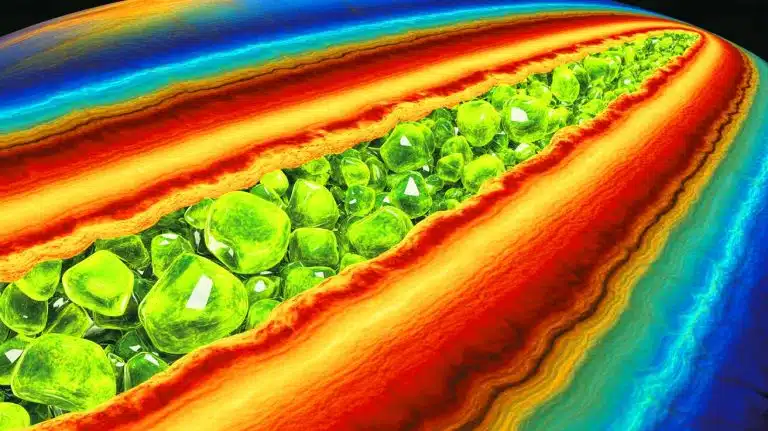| IN A NUTSHELL |
|
In a groundbreaking study, researchers have unveiled new insights into how water is transported deep into the Earth’s mantle. This discovery, revolving around the mineral olivine, suggests that only the oldest and fastest-sinking oceanic plates can carry water to significant depths. Conducted by a team from the University of Potsdam and the Helmholtz Centre for Geosciences, the study highlights the unique heat-conducting properties of olivine, which plays a critical role in this subterranean water transport. The findings, published in Nature Communications, could reshape our understanding of geological processes and deep-earth water reservoirs.
Understanding the Role of Olivine in Subduction
The Earth’s surface is composed of tectonic plates that float on the semi-fluid mantle beneath. These plates, when colliding, often lead to one plate being forced under another in a process called subduction. Oceanic plates, which are denser due to their olivine content, are more prone to subduction. Olivine, a mineral constituting about 80% of the oceanic lithosphere, is pivotal in this process.
As subducting oceanic plates descend into the mantle, they undergo a transformation influenced by the surrounding heat. The mineral olivine plays a significant role in this transformation due to its ability to conduct heat through radiation. This characteristic means that only older oceanic plates, aged over 60 million years and sinking faster than 10 centimeters per year, can efficiently transport water into the mantle. This discovery sheds light on the intricate relationship between plate age, descent speed, and their capacity to carry water to profound depths.
Jaya Anand Singh’s Research Path : A Journey from Curiosity to Contribution
Infrared Transparency of Olivine: A Groundbreaking Discovery
The research team, led by geodynamicist Enrico Marzotto, measured the transparency of olivine to infrared radiation under the extreme conditions found within the Earth’s mantle. This marks the first time such measurements have been conducted, revealing that olivine remains infrared transparent even under high pressure and temperature conditions.
This transparency is crucial because it affects how heat is transferred in the mantle. Radiation accounts for approximately 40% of the total heat diffused in the upper mantle, making it a key factor in the thermal evolution of subducting slabs. The ability of olivine to conduct heat through radiation accelerates the heating of descending slabs, influencing their density, rigidity, and capacity to transport water-bearing minerals deep into the Earth.
The Implications for Deep Earthquakes and Water Reservoirs
The rapid heating induced by radiative heat transport can lead to the breakdown of water-bearing minerals at shallower depths. This phenomenon could potentially explain the occurrence of deep earthquakes in the slabs. These earthquakes, occurring at depths greater than 70 kilometers, are influenced by the thermal and mechanical properties of the subducting slabs.
Only slabs older than 60 million years and sinking at speeds greater than 10 centimeters per year remain cold enough to transport water-bearing minerals to the Mantle Transition Zone (MTZ), located between 410 and 660 kilometers in depth. The MTZ is believed to be the planet’s largest water reservoir, potentially containing up to three times more water than the Earth’s oceans. This revelation underscores the importance of understanding the dynamics of subduction and the role of olivine in the Earth’s water cycle.
Future Directions and Geodynamic Implications
The study not only provides insights into the thermal dynamics of subduction but also offers numerical tools to model thermal anomalies in the mantle. These anomalies, whether hot or cold, play a significant role in Earth’s geodynamic behavior. The research offers a framework for understanding the lifetime and impact of these anomalies on the Earth’s interior processes.
Enrico Marzotto and his team have laid the groundwork for future research into the thermal and mechanical properties of the Earth’s mantle. As scientists continue to explore the implications of these findings, the role of olivine and its heat-conducting properties will remain a focal point in understanding the complex interactions within our planet’s interior.
This study opens new avenues for understanding the Earth’s internal processes and the dynamic behavior of tectonic plates. As researchers delve deeper into the mysteries of the Earth’s mantle, one question remains: How will these findings influence our understanding of the planet’s geological and hydrological cycles in the years to come?
Did you like it? 4.6/5 (26)






Fascinating read! How does this discovery impact our understanding of plate tectonics as a whole?
Wow, olivine sounds like a superstar mineral! 🌟
Can someone explain how infrared transparency in olivine was measured? I’m curious about the tech behind it.
Does this mean younger oceanic plates don’t play a role in water transport?
My geology professor would be thrilled with this discovery! 📚
Great article! How does this affect predictions of volcanic activity?
Is this discovery applicable to other minerals, or is it olivine-specific?
So the Earth has a secret underground water reservoir? That’s mind-blowing! 💧
How sure are we about the age and speed criteria for oceanic plates? Could there be exceptions?
What are the implications for earthquake prediction and monitoring?